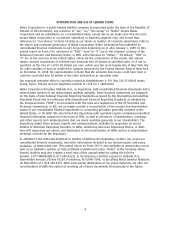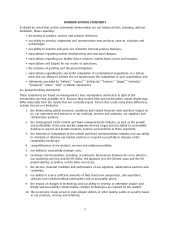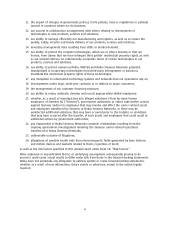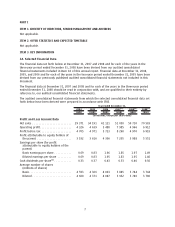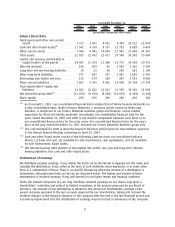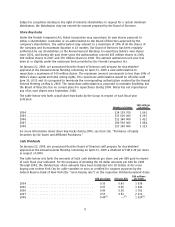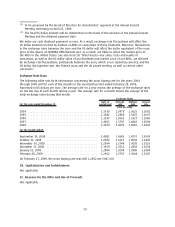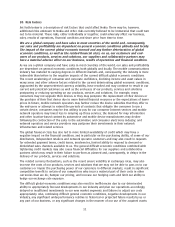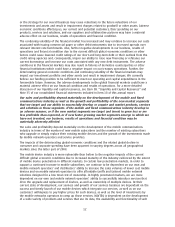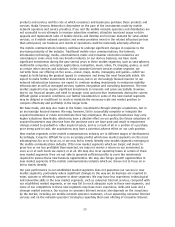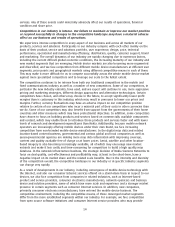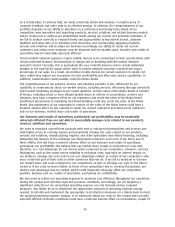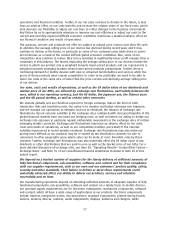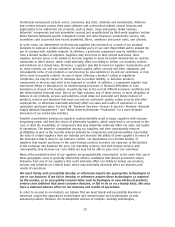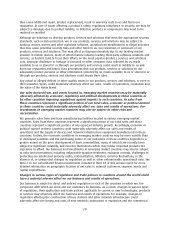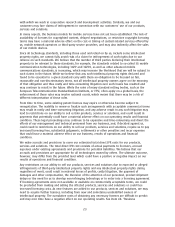Nokia 2008 Annual Report Download - page 14
Download and view the complete annual report
Please find page 14 of the 2008 Nokia annual report below. You can navigate through the pages in the report by either clicking on the pages listed below, or by using the keyword search tool below to find specific information within the annual report.products and services and the rate at which consumers and businesses purchase these products and
services. Nokia Siemens Networks is dependent on the pace of the investments made by mobile
network operators and service providers. If we and the mobile network operators and distributors are
not successful in our attempts to increase subscriber numbers, stimulate increased usage or drive
upgrade and replacement sales of mobile devices and develop and increase demand for valueadded
services, or if mobile network operators and service providers invest in the related infrastructure less
than anticipated, our business and results of operations could be materially adversely affected.
The mobile communications industry continues to undergo significant changes in response to the
increasing maturity of the industry. Traditional mobile voice communications, the Internet,
information technology, media, entertainment, music and consumer electronics industries are
converging in some areas into one broader industry. In our devices business, we have made
significant investments during the past several years in these market segments, such as smartphones,
multimedia computers, enterprise applications, navigation, music, video, TV, imaging, games, as well
as certain other services and solutions. In the consumer Internet services market segment, we
currently focus our offering on five areas—music, maps, media, messaging and games—which we
regard as both having the greatest appeal to consumers and being the most financially viable. We
expect to make further investments in these areas, but in an increasingly focused manner. In our
network infrastructure business, we expect to continue making investments in enterprise mobility
infrastructure as well as managed services, systems integration and consulting businesses. The new
market segments may require significant investments to innovate and grow successfully. However,
due to our financial targets and need to manage costs and prioritize investments during the current
difficult global economic conditions, our further investments in some of the new market segments
may be delayed or insufficient to reach or maintain the necessary scale and market position to
compete effectively and profitably in the longer term.
We have made, and may also make in the future, investments through strategic acquisitions, but in
an increasingly focused manner. We may, however, fail to successfully complete or integrate the
acquired businesses or retain and motivate their key employees; the acquired businesses may carry
higher valuations than Nokia, which may have a dilutive effect on our profits; the future valuations of
acquired businesses may decrease from the purchase price we have paid and result in impairment
charges related to goodwill or other acquired assets; and as a result of all or a portion of a purchase
price being paid in cash, the acquisitions may have a potential adverse effect on our cash position.
New market segments in the mobile communications industry are in different stages of development.
Accordingly, it may be difficult for us to accurately predict which new market segments are the most
advantageous for us to focus on, or we may fail to timely identify new market segments emerging in
the mobile communications industry. If the new market segments which we target and invest in
grow less or are less profitable than expected, we may not receive a return on our investment as
soon as or at such levels we expect, or at all. We may also incur operating losses in certain of these
new market segments if we are not able to generate sufficient profits to cover the investments
required to pursue these new business opportunities. We may also forego growth opportunities in
new market segments of the mobile communications industry which we choose not to focus on or
fail to timely identify.
Our past performance in our established market segments does not guarantee our success in new
market segments, particularly where significant changes to the way we do business are required to
enter, operate or effectively compete in these segments. We may have less experience, technological
and innovative skills in the new market segments, such as consumer Internet services, compared with
our established market segments, or we may fail to reach adequate scale in these new segments, and
some of our competitors in these new segments may have more experience, skills and scale and a
stronger market presence. Our success in consumer Internet services also depends on the acceptance
by the market, including our mobile network operator customers, of our expanding consumer Internet
services and on the network operators’ strategies regarding their own offering of consumer Internet
13



